X-ray Spectroscopy Study of Defect Contribution to Lithium Adsorption on Porous Carbon
Abstract
:1. Introduction
2. Materials and Methods
2.1. Synthesis
2.2. Characterization
2.3. Electrochemical Measurements
2.4. Calculation Details
3. Results and Discussion
3.1. Characterization of As-Grown PC
3.2. Effect of Lithium Deposition
3.3. DFT Modeling
3.4. Electrochemical Testing
4. Conclusions
Author Contributions
Funding
Data Availability Statement
Acknowledgments
Conflicts of Interest
References
- Arico, A.S.; Bruno, P.; Sctostati, B.; Tarascon, J.; Schalkwijk, W.V. Nanostructured Materials for advanced energy conversion and storage devices. Nat. Mater. 2005, 4, 366–377. [Google Scholar] [CrossRef]
- Zhang, H.; Yang, Y.; Ren, D.; Wang, L.; He, X. Graphite as anode materials: Fundamental mechanism, recent progress and advances. Energy Storage Mater. 2021, 36, 147–170. [Google Scholar] [CrossRef]
- Yaroslavtsev, A.B.; Kulova, T.L.; Skundin, A.M. Electrode nanomaterials for lithium-ion batteries. Russ. Chem. Rev. 2015, 84, 826–852. [Google Scholar]
- Nai, J.; Zhao, X.; Yuan, H.; Tao, X.; Guo, L. Amorphous carbon-based materials as platform for advanced high performance anodes in lithium secondary batteries. Nano Res. 2021, 14, 2053–2066. [Google Scholar] [CrossRef]
- Deng, L.; Wei, T.; Liu, J.; Zhan, L.; Chen, W.; Cao, J. Recent developments of carbon-based anode materials for flexible lithium-ion batteries. Crystals 2022, 12, 1279. [Google Scholar] [CrossRef]
- Nzereogu, P.U.; Omah, A.D.; Ezema, F.I.; Iwuoha, E.I.; Nwanya, A.C. Anode materials for lithium-ion batteries: A review. Appl. Surf. Sci. Adv. 2022, 9, 100233. [Google Scholar]
- Han, S.; Wu, D.; Li, S.; Zhang, F.; Feng, X. Graphene: A two-dimensional platform for lithium storage. Small 2013, 9, 1173–1187. [Google Scholar] [PubMed]
- Pollak, E.; Geng, B.; Jeon, K.-J.; Lucas, I.T.; Richardson, T.J.; Wang, F.; Kostecki, R. The interaction of Li+ with single-layer and few-layer graphene. Nano Lett. 2010, 10, 3386–3388. [Google Scholar] [CrossRef] [PubMed]
- Fan, X.; Zheng, W.T.; Kuo, J.-L.; Singh, D.J. Adsorption of single li and the formation of small Li clusters on graphene for the anode of lithium-ion batteries. ACS Appl. Mater. Interfaces 2013, 5, 7793–7797. [Google Scholar] [CrossRef] [PubMed]
- Lavagna, L.; Meligrana, G.; Gerbaldi, C.; Tagliaferro, A.; Bartoli, M. Graphene and lithium-based battery electrodes: A review of recent literature. Energies 2020, 13, 4867. [Google Scholar] [CrossRef]
- Guo, H.; Long, D.; Zheng, Z.; Chen, X.; Ng, A.M.C.; Lu, M. Defect-enhanced performance of a 3D graphene anode in a lithium-ion battery. Nanotechnology 2017, 28, 505402. [Google Scholar] [PubMed]
- Etacheri, V.; Wang, C.; O’Connell, M.J.; Chan, C.K.; Pol, V.G. Porous carbon sphere anodes for enhanced lithium-ion storage. J. Mater. Chem. A 2015, 3, 9861–9868. [Google Scholar] [CrossRef]
- Guan, Z.; Guan, Z.; Li, Z.; Liu, J.; Yu, K. Characterization and preparation of nanoporous carbon derived from hemp stems as anode for lithium-ion batteries. Nanoscale Res. Lett. 2019, 14, 338. [Google Scholar] [CrossRef]
- Li, L.; Zhang, D.; Deng, J.; Gou, Y.; Fang, J.; Cui, H.; Zhao, Y.; Cao, M. Carbon-based materials for fast charging lithium-ion batteries. Carbon 2021, 185, 721–734. [Google Scholar] [CrossRef]
- Nazhipkyzy, M.; Maltay, A.B.; Askaruly, K.; Assylkhanova, D.D.; Seitkazinova, A.R.; Mansurov, Z.A. Biomass-derived porous carbon materials for Li-ion battery. Nanomaterials 2022, 12, 3710. [Google Scholar] [CrossRef]
- Zhang, D.; Su, W.; Li, Z.; Wang, Q.; Yuan, F.; Sun, H.; Li, Y.; Zhang, Y.; Wang, B. Three-dimensional interconnected porous carbon nanoflakes with improved electron transfer and ion storage for lithium-ion batteries. J. Alloys Compd. 2022, 904, 164122. [Google Scholar] [CrossRef]
- Lee, J.; Kim, J.; Hyeon, T. Recent progress in the synthesis of porous carbon materials. Adv. Mater. 2006, 18, 2073–2094. [Google Scholar] [CrossRef]
- Wu, L.; Li, Y.; Fu, Z.; Su, B.-L. Hierarchically structured porous materials: Synthesis strategies and applications in energy storage. Natl. Sci. Rev. 2020, 7, 1667–1701. [Google Scholar] [CrossRef] [PubMed]
- Sun, L.; Gong, Y.; Li, D.; Pan, C. Biomass-derived porous carbon materials: Synthesis, designing, and applications for supercapacitors. Green Chem. 2022, 24, 3864–3894. [Google Scholar] [CrossRef]
- Díez, N.; Sevilla, M.; Fuertes, A.B. Synthesis strategies of templated porous carbons beyond the silica nanocasting techniqu. Carbon 2021, 178, 451–476. [Google Scholar] [CrossRef]
- Pang, Z.; Li, G.; Xiong, X.; Ji, L.; Xu, Q.; Zou, X.; Lu, X. Molten salt synthesis of porous carbon and its application in supercapacitors: A review. J. Energy Chem. 2021, 61, 622–640. [Google Scholar] [CrossRef]
- Shlyakhova, E.V.; Bulusheva, L.G.; Kanygin, M.A.; Plyusnin, P.E.; Kovalenko, K.A.; Senkovskiy, B.V.; Okotrub, A.V. Synthesis of nitrogen-containing porous carbon using calcium oxide nanoparticles. Phys. Status Solidi B 2014, 251, 2607–62612. [Google Scholar] [CrossRef]
- Shlyakhova, E.V.; Okotrub, A.V.; Fedoseeva, Y.V.; Fedorovskaya, E.O.; Mel’gunova, E.A.; Mel’gunov, M.S.; Koroteev, V.O.; Makarova, A.A.; Zhou, J.; Song, H.; et al. Iron induced porosity of the templated carbon for enhancement of electrochemical capacitance. Appl. Surf. Sci. 2021, 543, 148565. [Google Scholar] [CrossRef]
- Nishchakova, A.D.; Grebenkina, M.A.; Shlyakhova, E.V.; Shubin, Y.V.; Kovalenko, K.A.; Asanov, I.P.; Fedoseeva, Y.V.; Makarova, A.A.; Okotrub, A.V.; Bulusheva, L.G. Porosity and composition of nitrogen-doped carbon materials templated by the thermolysis products of calcium tartrate and their performance in electrochemical capacitors. J. Alloys Compd 2021, 858, 158259. [Google Scholar] [CrossRef]
- Fedoseeva, Y.V.; Shlyakhova, E.V.; Vorfolomeeva, A.A.; Grebenkina, M.A.; Sysoev, V.I.; Stolyarova, S.G.; Maksimovskiy, E.A.; Makarova, A.A.; Okotrub, A.V.; Bulusheva, L.G. Tuning nitrogen-doped carbon electrodes via synthesis temperature adjustment to improve sodium- and lithium-ion storage. Batteries 2023, 9, 45. [Google Scholar] [CrossRef]
- Yang, G.; Li, X.; Guan, Z.; Tong, Y.; Xu, B.; Wang, X.; Wang, Z.; Chen, L. Insights into lithium and sodium storage in porous carbon. Nano Lett. 2020, 20, 3836–3843. [Google Scholar] [CrossRef]
- Ritchie, J.P.; Bachrach, S.M. Bond paths and bond properties of carbon-lithium bonds. J. Am. Chem. Soc. 1987, 109, 5909–5916. [Google Scholar] [CrossRef]
- Chan, K.T.; Neaton, J.B.; Cohen, M.L. First-principles study of metal adatom adsorption on graphene. Phys. Rev. B 2008, 77, 235430. [Google Scholar] [CrossRef]
- Medeiros, P.V.C.; de Brito Mota, F.; Mascarenhas, A.J.S.; de Castilho, C.M.C. Bonding character of lithium atoms adsorbed on a graphene layer. Solid State Commun. 2011, 151, 529–531. [Google Scholar] [CrossRef]
- Medeiros, P.V.C.; de Brito Mota, F.; Mascarenhas, A.J.S.; de Castilho, C.M.C. Adsorption of monovalent metal atoms on graphene: A theoretical approach. Nanotechnology 2010, 21, 115701. [Google Scholar] [CrossRef]
- Kim, M.; Fernando, J.F.S.; Wang, J.; Nanjundan, A.K.; Na, J.; Hossain, M.S.A.; Nara, H.; Martin, D.; Sugahara, Y.; Golberg, D.; et al. Efficient lithium-ion storage using a heterostructured porous carbon framework and its in situ transmission electron microscopy study. Chem. Commun. 2022, 58, 863–866. [Google Scholar] [CrossRef]
- Zou, J.; Sole, C.; Drewett, N.E.; Velicky, M.; Hardwick, L.J. In situ study of Li intercalation into highly crystalline graphitic flakes of varying thicknesses. J. Phys. Chem. Lett. 2016, 7, 4291–4296. [Google Scholar] [CrossRef] [PubMed]
- Cheng, X.; Li, H.; Zhao, Z.; Wang, Y.; Wang, X. The use of in-situ Raman spectroscopy in investigating carbon materials as anodes of alkali metal-ion batteries. New Carbon Mater. 2021, 36, 93–105. [Google Scholar] [CrossRef]
- Letellier, M.; Chevallier, F.; Béguin, F. In situ 7Li NMR during lithium electrochemical insertion into graphite and a carbon/carbon composite. J. Phys. Chem. Solids 2006, 67, 1228–1232. [Google Scholar] [CrossRef]
- Bulusheva, L.G.; Kanygin, M.A.; Arkhipov, V.E.; Popov, K.M.; Fedoseeva, Y.V.; Smirnov, D.A.; Okotrub, A.V. In situ X-ray photoelectron spectroscopy study of lithium interaction with graphene and nitrogen-doped graphene films produced by chemical vapor deposition. J. Phys. Chem. C 2017, 121, 5108–5114. [Google Scholar] [CrossRef]
- Fedoseeva, Y.V.; Lapteva, L.L.; Makarova, A.A.; Bulusheva, L.G.; Okotrub, A.V. Charge polarization in partially lithiated single-walled carbon nanotubes. Phys. Chem. Chem. Phys. 2018, 20, 22592–22599. [Google Scholar] [CrossRef]
- Lapteva, L.L.; Fedoseeva, Y.V.; Shlyakhova, E.V.; Makarova, A.A.; Bulusheva, L.G.; Okotrub, A.V. NEXAFS spectroscopy study of lithium interaction with nitrogen incorporated in porous graphitic material. J. Mater. Sci. 2019, 54, 11168–11178. [Google Scholar] [CrossRef]
- Datta, D.; Li, J.; Koratkar, N.; Shenoy, V.B. Enhanced lithiation in defective graphene. Carbon 2014, 80, 305–310. [Google Scholar] [CrossRef]
- Yildirim, H.; Kinaci, A.; Zhao, Z.-J.; Chan, K.Y.M.; Greeley, J.P. First-principles analysis of defect-mediated Li adsorption on graphene. ACS Appl. Mater. Interfaces 2014, 6, 21141–21150. [Google Scholar] [CrossRef]
- Zhao, Y.; Truhlar, D.G. The M06 suite of density functionals for main group thermochemistry, thermochemical kinetics, noncovalent interactions, excited states, and transition elements: Two new functionals and systematic testing of four M06-class functionals and 12 other functionals. Theor. Chem. Acc. 2008, 120, 215. [Google Scholar]
- Bochevarov, A.D.; Harder, E.; Hughes, T.F.; Greenwood, J.R.; Braden, D.A.; Philipp, D.M.; Rinaldo, D.; Halls, M.D.; Zhang, J.; Friesner, R.A. Jaguar: A high-performance quantum chemistry software program with strengths in life and materials sciences. Int. J. Quantum Chem. 2013, 113, 2110–2142. [Google Scholar] [CrossRef]
- Natural Bond Orbital 7.0 Home. Available online: http://nbo6.chem.wisc.edu (accessed on 15 November 2018).
- Nakamizo, M.; Honda, H.; Inagaki, M. Raman spectra of ground natural graphite. Carbon 1978, 16, 281–283. [Google Scholar] [CrossRef]
- Chu, P.K.; Li, L. Characterization of amorphous and nanocrystalline carbon films. Mat. Chem. Phys. 2006, 96, 253–277. [Google Scholar] [CrossRef]
- Carlisle, J.A.; Shirley, E.L.; Hudson, E.A.; Terminello, L.J.; Callcott, T.A.; Jia, J.J.; Ederer, D.L.; Perera, R.C.C.; Himpse, F.J. Probing the graphite band structure with resonant soft-X-ray fluorescence. Phys. Rev. Lett. 1995, 74, 1234–1237. [Google Scholar] [CrossRef]
- Bulusheva, L.G.; Okotrub, A.V.; Fedoseeva, Y.V.; Shlyakhova, E.V.; Huo, J.; Song, H.; Chen, X. Electronic state of carbon in nanostructured composites produced by co-carbonization of aromatic heavy oil and ferrocene. Mater. Chem. Phys. 2010, 122, 146–150. [Google Scholar] [CrossRef]
- Wertheim, G.K.; Van Attekum, P.T.; Basu, S. Electronic structure of lithium graphite. Solid State Commun. 1980, 33, 1127–1130. [Google Scholar] [CrossRef]
- Lapteva, L.L.; Fedoseeva, Y.V.; Gevko, P.N.; Smirnov, D.A.; Gusel’nikov, A.V.; Bulusheva, L.G.; Okotrub, A.V. X-ray spectroscopy study of lithiated graphite obtained by thermal deposition of lithium. J. Struct. Chem. 2017, 58, 1173–1179. [Google Scholar] [CrossRef]
- Shek, M.L.; Hrbek, J.; Sham, T.K.; Xu, G.-Q. A soft X-ray study of the interaction of oxygen with Li. Surf. Sci. 1990, 234, 324–334. [Google Scholar] [CrossRef]
- Oswald, S.; Thoss, F.; Zier, M.; Hoffmann, M.; Jaumann, T.; Herklotz, M.; Nikolowski, K.; Scheiba, F.; Kohl, M.; Giebeler, L.; et al. Binding energy referencing for XPS in alkali metalbased battery materials research (II): Application to complex composite electrodes. Batteries 2018, 4, 36. [Google Scholar] [CrossRef]
- Schmieg, S.J.; Belton, D.N. Highly oriented pyrolytic graphite by XPS. Surf. Sci. Spectra 1992, 1, 333–336. [Google Scholar] [CrossRef]
- Díaz, J.; Paolicelli, G.; Ferrer, S.; Comin, F. Separation of the sp3 and sp2 components in the C 1s photoemission spectra of amorphous carbon films. Phys. Rev. B 1996, 54, 8064–8069. [Google Scholar] [CrossRef] [PubMed]
- Blyth, R.I.R.; Buqa, H.; Netzer, F.P.; Ramsey, M.G.; Besenhard, J.O.; Golob, P.; Winter, M. XPS studies of graphite electrode materials for lithium ion batteries. Appl. Surf. Sci. 2000, 167, 99–106. [Google Scholar] [CrossRef]
- Brandes, J.; Cody, G.; Rumble, D.; Haberstroh, P.; Wirick, S.; Gelinas, Y. Carbon K-edge XANES spectromicroscopy of natural graphite. Carbon 2008, 46, 1424–1434. [Google Scholar] [CrossRef]
- Fedoseeva, Y.V.; Pozdnyakov, G.A.; Okotrub, A.V.; Kanygin, M.A.; Nastaushev, Y.V.; Vilkov, O.Y.; Bulusheva, L.G. Effect of substrate temperature on the structure of amorphous oxygenated hydrocarbon films grown with a pulsed supersonic methane plasma flow. Appl. Surf. Sci. 2016, 385, 464–471. [Google Scholar] [CrossRef]
- Zhang, L.; Li, X.; Augustsson, A.; Lee, C.M.; Rubensson, J.-E.; Nordgren, J.; Ross Jr, P.N.; Guo, J.-H. Revealing the electronic structure of LiC6 by soft X-ray spectroscopy. Appl. Phys. Lett. 2017, 110, 104106. [Google Scholar] [CrossRef]
- Boesenberg, U.; Sokaras, D.; Nordlund, D.; Weng, T.-C.; Gorelov, E.; Richardson, T.J.; Kostecki, R.; Cabana, J. Electronic structure changes upon lithium intercalation into graphite—Insights from ex situ and operando X-ray Raman spectroscopy. Carbon 2019, 143, 371–377. [Google Scholar] [CrossRef]
- Bhatt, M.D.; Kim, H.; Kim, G. Various defects in graphene: A review. RSC Adv. 2022, 12, 21520–21547. [Google Scholar] [CrossRef]
- Kim, G.; Jhi, S.-H.; Lim, S.; Park, N. Effect of vacancy defects in graphene on metal anchoring and hydrogen adsorption. Appl. Phys. Lett. 2009, 94, 173102. [Google Scholar] [CrossRef]
- Ochapski, M.W.; Ataç, D.; Sanderink, J.G.M.; Kovalgin, A.Y.; de Jong, M.P. Li intercalation into multilayer graphene with controlled defect densities. Carbon Trends 2021, 4, 100045. [Google Scholar] [CrossRef]
- Cheng, Z.; Zhang, X.; Zhang, H.; Liu, H.; Yu, X.; Dai, X.; Liu, G.; Chen, G. Large vacancy-defective graphene for enhanced lithium storage. Carbon Trends 2023, 10, 100237. [Google Scholar] [CrossRef]
- Pattarapongdilok, N.; Parasuk, V. Adsorptions of lithium ion/atom and packing of Li ions on graphene quantum dots: Application for Li-ion battery. Comput. Theor. Chem. 2020, 1177, 11277. [Google Scholar] [CrossRef]
- Sozykin, S.A.; Beskachko, V.P. Characteristics of lithium adsorption near divacancy defects on carbon nanotubes (7,7). Diam. Relat. Mater. 2017, 79, 127–132. [Google Scholar] [CrossRef]
- Omidvar, A. Defective carbon nanocone as an anode material for lithium-ion batteries. ACS Appl. Energy Mater. 2020, 3, 11463–11469. [Google Scholar] [CrossRef]
- Pašti, I.A.; Jovanovié, A.; Dobrota, A.S.; Mentus, S.V.; Johansson, B.; Skorodumova, N.V. Atomic adsorption on graphene with a single vacancy: Systematic DFT study through the periodic table of elements. Phys. Chem. Chem. Phys. 2018, 20, 858–865. [Google Scholar] [CrossRef] [PubMed]
- Dimakis, N.; Salas, I.; Gonzalez, L.; Vadodaria, O.; Ruiz, K. Li and Na adsorption on graphene and graphene oxide examined by density functional theory quantum theory of atoms in molecules and electron localization function. Molecules 2019, 24, 754. [Google Scholar] [CrossRef]
- An, S.J.; Li, J.; Daniel, C.; Mohanty, D.; Nagpure, S.; Wood III, D.L. The state of understanding of the lithium-ion-battery graphite solid electrolyte interphase (SEI) and its relationship to formation cycling. Carbon 2016, 105, 52–76. [Google Scholar] [CrossRef]
- Wang, A.; Kadam, S.; Li, H.; Shi, S.; Qi, Y. Review on modeling of the anode solid electrolyte interphase (SEI) for lithium-ion batteries. NPJ Comput. Mater. 2018, 4, 15. [Google Scholar] [CrossRef]
- Asenbauer, J.; Eisenmann, T.; Kuenzel, M.; Kazzazi, A.; Chen, Z.; Bresser, D. The success story of graphite as a lithium-ion anode material—Fundamentals, remaining challenges, and recent developments including silicon (oxide) composites. Sustain. Energy Fuels 2020, 4, 5387. [Google Scholar]
- Parimalam, B.S.; MacIntosh, A.D.; Kadam, R.; Lucht, B.L. Decomposition reactions of anode solid electrolyte interphase (SEI) components with LiPF6. J. Phys. Chem. C 2017, 121, 22733–22738. [Google Scholar] [CrossRef]

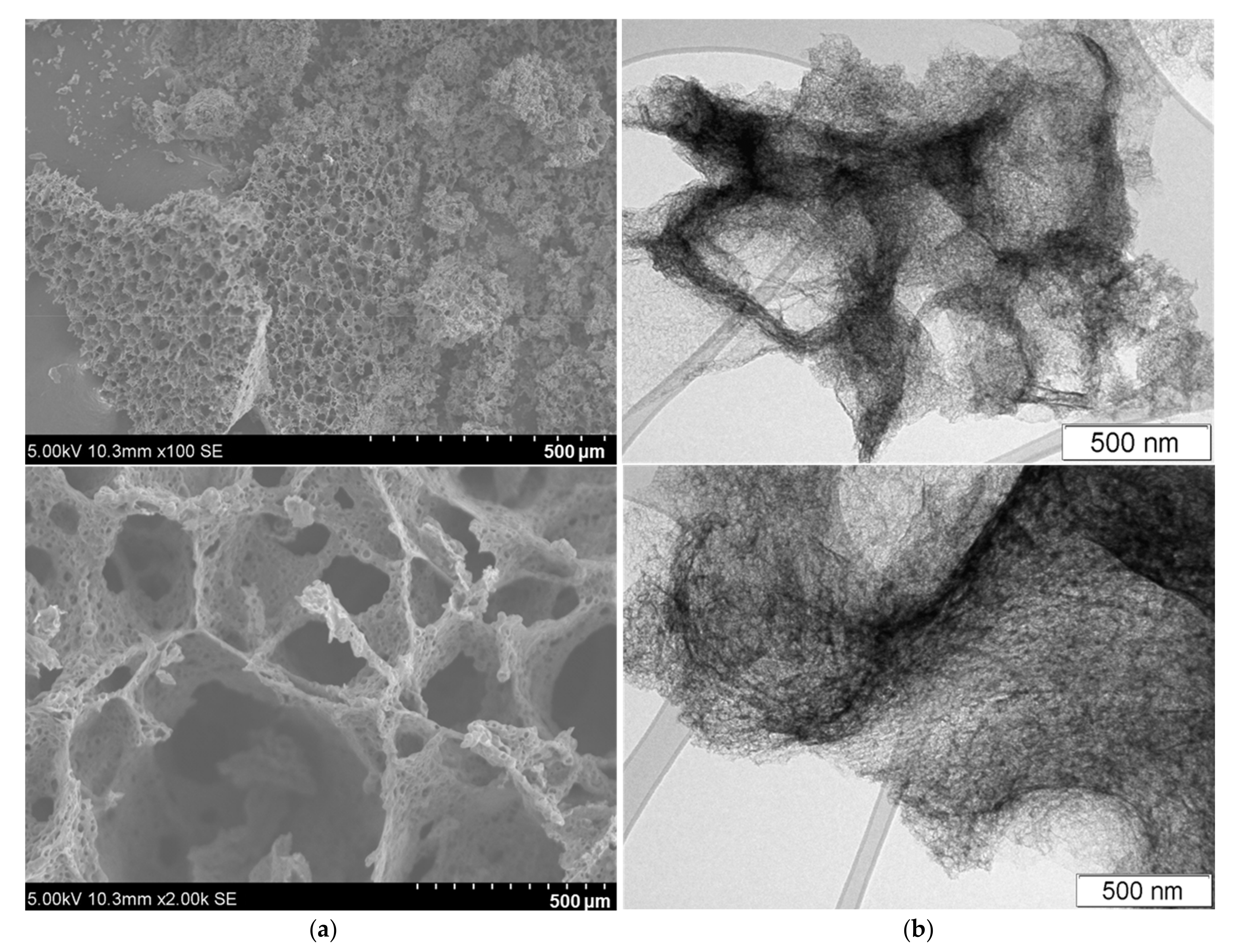
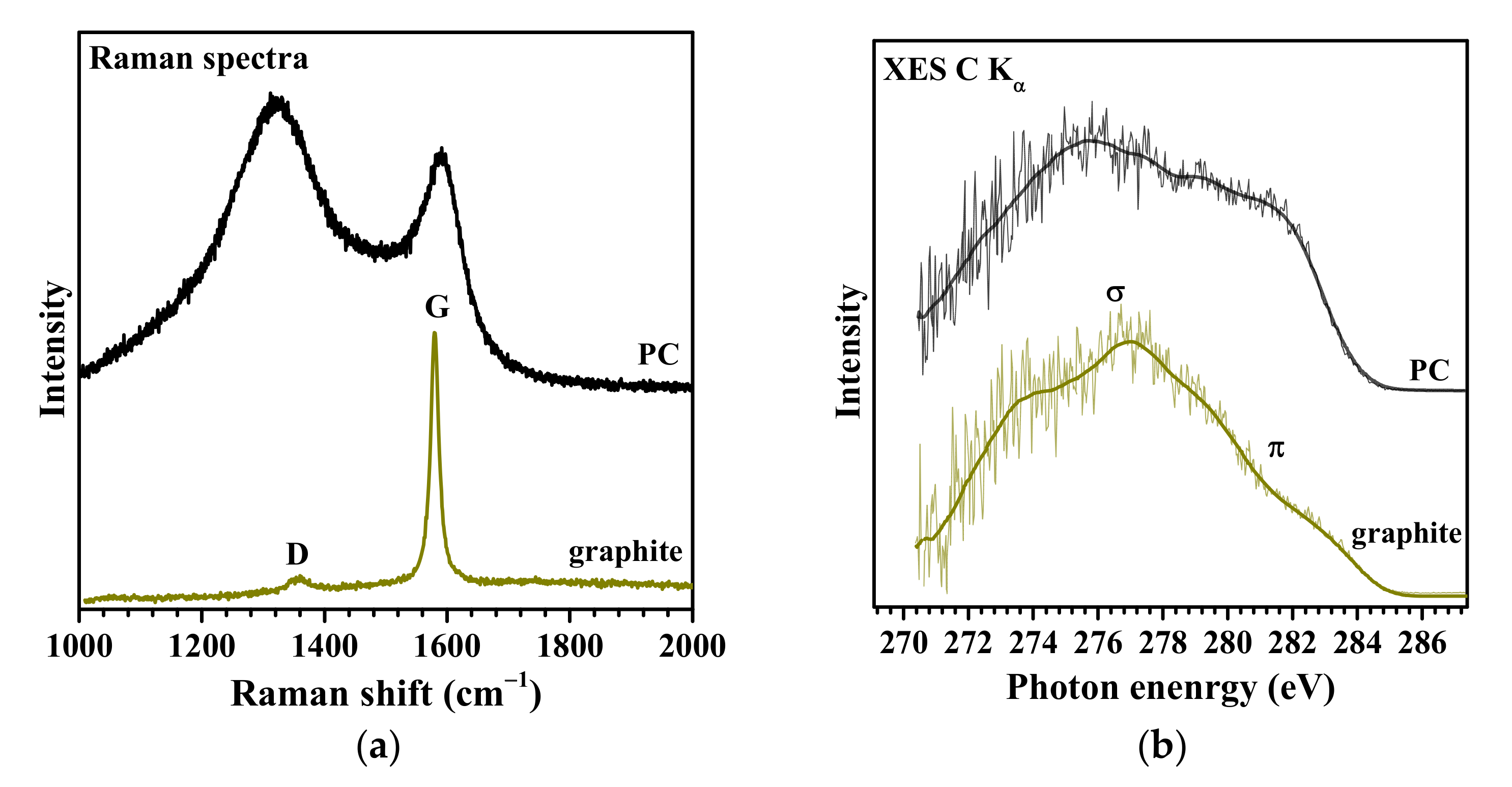
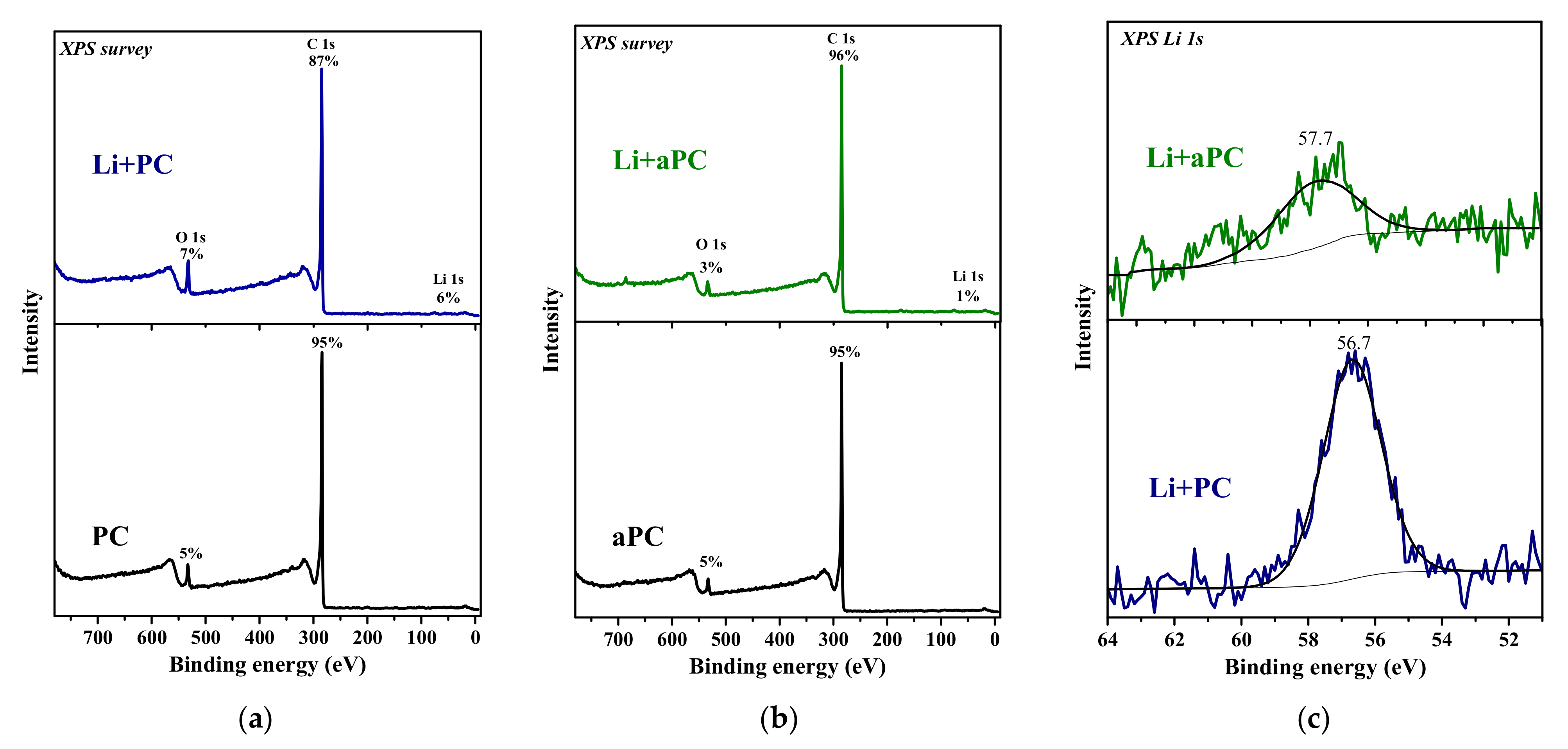
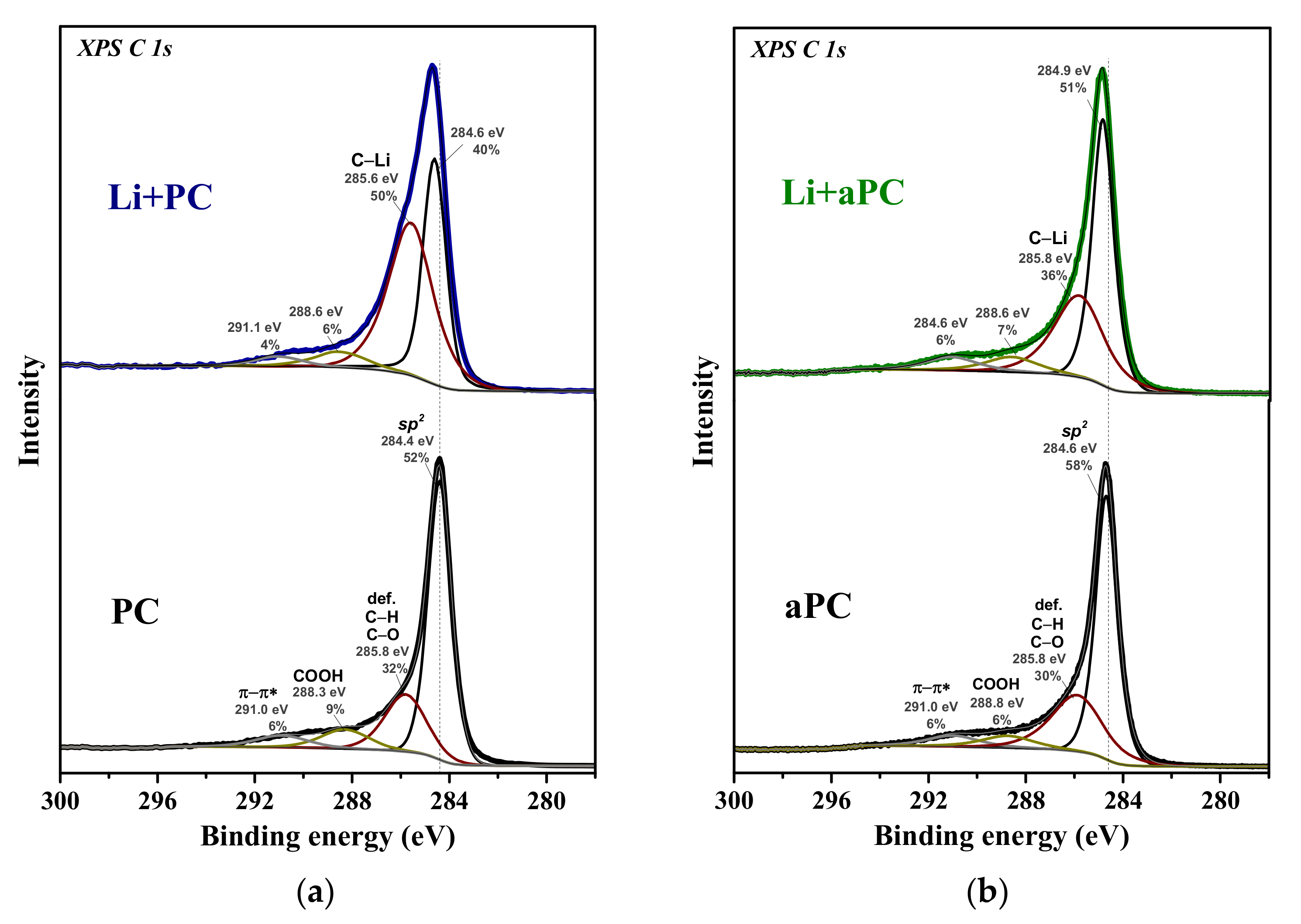

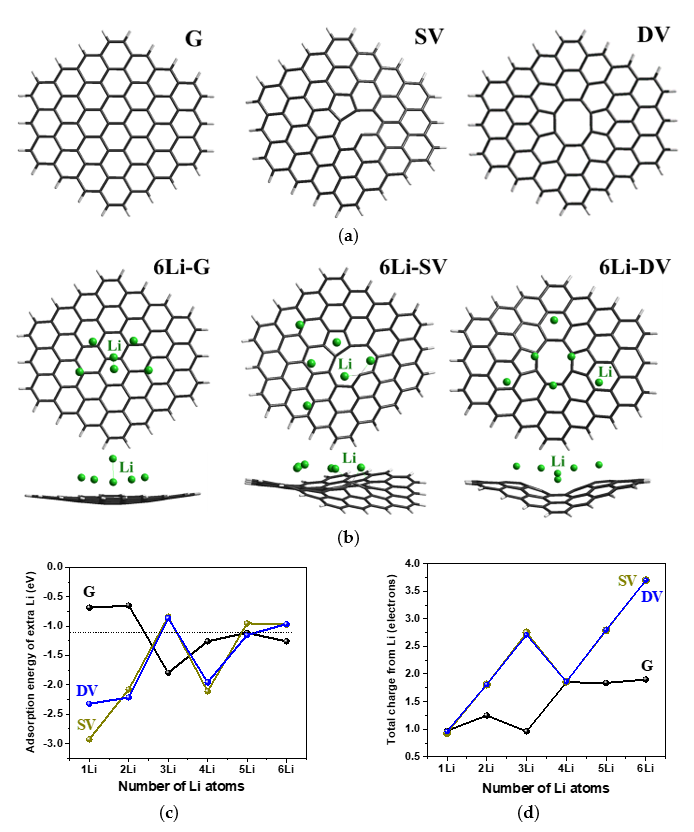
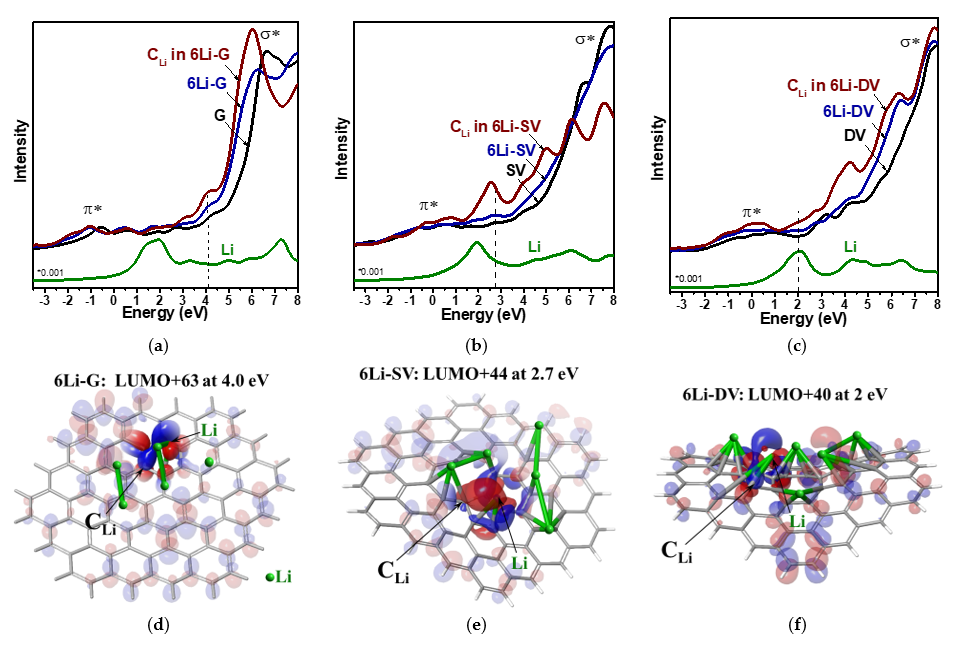


Disclaimer/Publisher’s Note: The statements, opinions and data contained in all publications are solely those of the individual author(s) and contributor(s) and not of MDPI and/or the editor(s). MDPI and/or the editor(s) disclaim responsibility for any injury to people or property resulting from any ideas, methods, instructions or products referred to in the content. |
© 2023 by the authors. Licensee MDPI, Basel, Switzerland. This article is an open access article distributed under the terms and conditions of the Creative Commons Attribution (CC BY) license (https://creativecommons.org/licenses/by/4.0/).
Share and Cite
Fedoseeva, Y.V.; Shlyakhova, E.V.; Makarova, A.A.; Okotrub, A.V.; Bulusheva, L.G. X-ray Spectroscopy Study of Defect Contribution to Lithium Adsorption on Porous Carbon. Nanomaterials 2023, 13, 2623. https://doi.org/10.3390/nano13192623
Fedoseeva YV, Shlyakhova EV, Makarova AA, Okotrub AV, Bulusheva LG. X-ray Spectroscopy Study of Defect Contribution to Lithium Adsorption on Porous Carbon. Nanomaterials. 2023; 13(19):2623. https://doi.org/10.3390/nano13192623
Chicago/Turabian StyleFedoseeva, Yuliya V., Elena V. Shlyakhova, Anna A. Makarova, Alexander V. Okotrub, and Lyubov G. Bulusheva. 2023. "X-ray Spectroscopy Study of Defect Contribution to Lithium Adsorption on Porous Carbon" Nanomaterials 13, no. 19: 2623. https://doi.org/10.3390/nano13192623
APA StyleFedoseeva, Y. V., Shlyakhova, E. V., Makarova, A. A., Okotrub, A. V., & Bulusheva, L. G. (2023). X-ray Spectroscopy Study of Defect Contribution to Lithium Adsorption on Porous Carbon. Nanomaterials, 13(19), 2623. https://doi.org/10.3390/nano13192623






